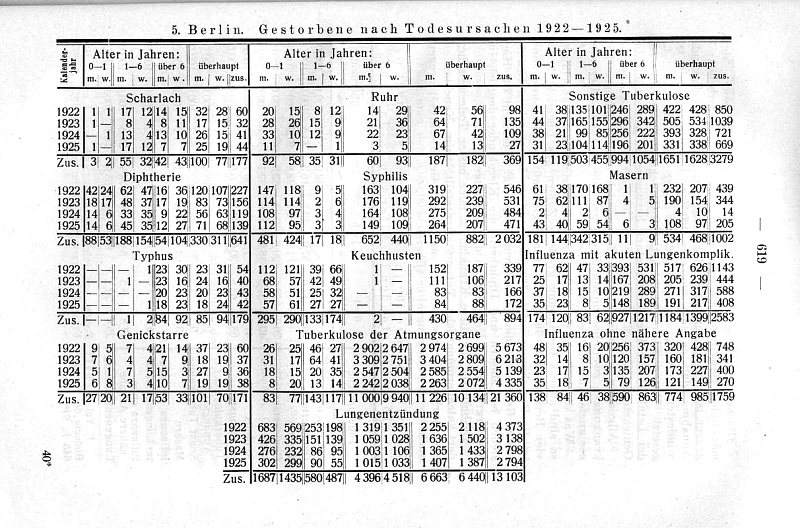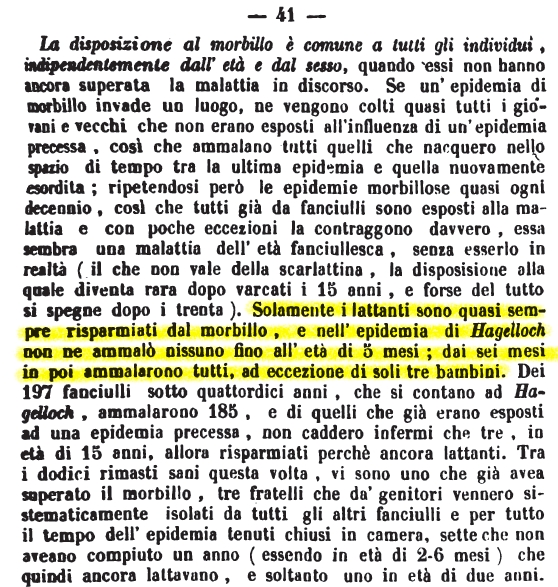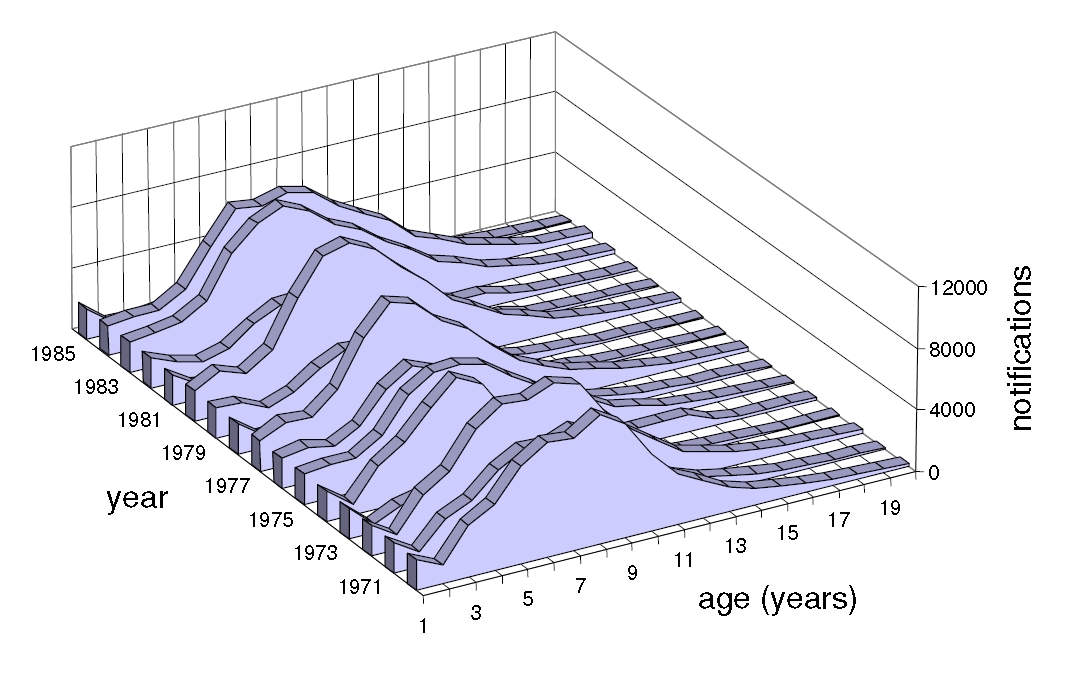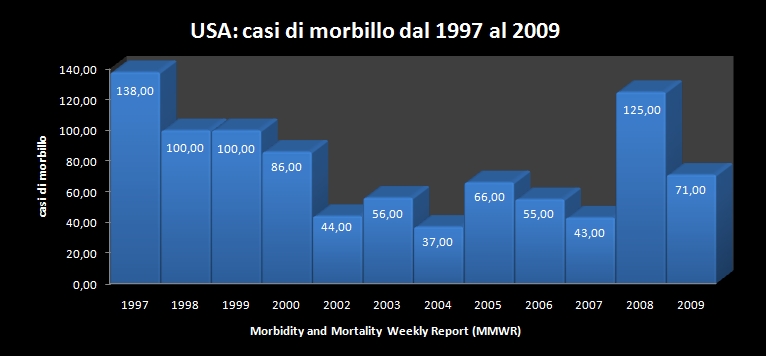The articles I have written so far for this blog on measles and when I looked at some of these rumors are
measles vaccine and risk of subacute sclerosing panencephalitis (SSPE)
The measles vaccine : The effectiveness
The measles vaccine can cause death?
Three other items in my site Vaccinfo Chapter "Caught in the Net" (a collection of rumors found on the web, in books, radio and TV etc.)
The effectiveness del vaccino antimorbillo: il caso USA
Il vaccino antimorbillo e la meningite asettica
Il morbillo in Italia nel 2007
L'argomento che tratterò oggi è abbastanza complesso perciò lo suddividerò in due post.
Ho trovato un buon riassunto delle critiche mosse da parte degli antivaccinisti nel libro del dott. Eugenio Serravalle (pediatra omeopata) "Bambini supervaccinati" che ho già usato altre volte in questo blog come punto di partenza per i miei post.
Lui scrive nell'articolo sul morbillo:
--------------------------------------------------------
Before you continue reading the article, I inform you that since 10.1.11, the Veneto Region has developed an online questionnaire for parents about vaccinations.
Please participate and run the link as much as possible.
----------------------------------------------- ---------
Measles is exceptional in the first year of life, thanks to the protection conferred by maternal antibodies, but in recent years have been no reports of illnesses in infants younger lower ai 12 mesi.
(.... la parte della citazione che qui ho tagliato - e che riguarda la differenza della quantità di anticorpi materni fra donne vaccinate e donne che hanno avuto il morbillo - sarà il tema della seconda parte)
Negli Stati Uniti un malato di morbillo su quattro è al di sotto dei dodici mesi e il 50% dei casi dichiarati di morbillo rientra nei gruppi a rischio, ossia di soggetti molto piccoli o adulti.
Nel 2006/07, nel corso di un'epidemia di morbillo a Barcellona, 123 malati su 213 erano al di sotto dei quindici mesi di età.
Let us now examine the original statement, that before the widespread use of vaccine measles cases in children from 0 to 1 year were exceptional.
prevaccinale era was well known that infants are at higher risk of serious complications and death from measles.
For example in the book "Das Heilwesen der Gegenwart und-Gesundheitslehre Gesundheitspolitik" Prof. Dr. Adolf Gottstein, Ministerialdirektor aD (Deutsche Buchgemeinschaft Berlin) in 1925 stated in the chapter on measles
Infants in the early months of life are almost always spared from measles. From the second quarter they too become ill. Più piccolo il bambino, più grande la sofferenza e più alta la mortalità. Il morbillo non è di per se una malattia mortale ma lo diventa se infetta un bambino molto piccolo. Proprio in questa fascia di età si registra il più alto numero di morti prevenibili. Nel 1913 in Prussia sono morte quasi 7300 persone di morbillo, di cui 2617 all'età di 0-1 anno , 2549 all'età di 1-2 anni, quindi un totale di 5156, e solo 550 di bambini di più di 5 anni.
Poi l'autore spiega la grande importanza di fare tutto il possibile per proteggere i lattanti dal contagio. Parla di un metodo scoperto da un pediatra di Monaco, un certo Degkwitz : un serum ricavato dal sangue di malati di morbillo o anche the product from the blood serum of adults (but this is less effective) may prevent or make milder the disease, when injected in time. The only problem was that you could not produce enough of this serum to protect all infants. But at least for those in hospitals, orphanages and nurseries in the serum was sufficient and the method was successful. The author hopes that sooner or later you will discover the causative agent of measles in order to develop a vaccine that protects infants.
In the 1934 book "Die deutsche Mutter und ihr erstes Kind" by Dr Johann Haarer, parents are advised to do everything possible to bring children from 6 to 12 months of living in isolation when there are cases of measles and explains that if the child is at greater risk of complications, in case of a suspected infection, the doctor will inject as soon as possible under the skin a little 'blood of the mother or father who is almost certainly had had measles, and that protects it for approx. three weeks.
Another example is the situation in the era prevaccinale in Berlin. The following table shows the causes of death among children of Berlin by the year 1922 -25 (ie approx. 40 years before the introduction of the vaccine).
is the number of measles deaths (Maserno) among children from 0 to 1 year. The number of cases was obviously much higher, as not all moiono measles (to enlarge This and other images, click on it):
1922: 99
1923: 137
1924: 6
1925: 83
In a medical journal, 1864 "The Morgagni" can be read:
"Only infants are almost always spared from measles, and In the outbreak of ill Hagelloch not no man until the age of 5 months from six months onwards, all ill, with the exception of only three children. "
The last example that I report the case of Italy in the last years before the measles vaccination and early start of the vaccination (even with a very low coverage). The graph shows a clear peak of cases in the age group between 0 to 1 year. The number of these reported cases is rather important, if you look at the value of the axis Y. The reported cases in this age group must have been ca. Year 2000.
Source: 1. Manfredi P, Cleur EM Williams JR Salmaso S, Atti MCD. The pre-vaccination regional Epidemiological landscape of measles in Italy : contact patterns, effort needed for Eradication, and comparison with other regions of Europe. Population Health Metrics. 2005, 3 (1): 1.
As you can see, even the antibodies of women who had had measles did not protect children throughout the first year of life and it is not true that only now beginning to see these cases.
But what's the matter of the increase in measles cases in the age group most at risk? And 'real or not?
must know that vaccinia use this argument to convince parents that measles is a dangerous thing that moves forward in the age of the patients, and is thus the people who are at higher risk of complications (children in the first year of lives, adolescents and adults). They are absolutely right, except that the percentage increase of cases in the age group at highest risk is only relative but not absolute. (Da notare anche che questo argomento contraddice quello che i vaccini, incluso l'antimorbillo, non sono efficaci e non hanno avuto nessuna influenza sull'andamento epidemiologico.)
Nel Weekly Epidemiological Report 1981 N° 42 dell'Organizzazione Mondiale della Sanità ho trovato un esempio che spiega molto bene la differenza tra l'incidenza relativa e assoluta.
A Zhuji, nella provincia di Zhenjang, Cina (che negli anni 70 aveva una popolazione di ca. 1 milione) il vaccino antimorbillo era stato introdotto nel 1966 e la vaccinazione è stata intensificata nel 1973.
Guardando le notifiche dei casi di morbillo dal 1954 fino al 1980 si possono notare 3 stadi:
1) before the introduction of measles vaccination, there were outbreaks every 1-3 years. The highest incidence was casi/100.000 4563 population (in 1958) and lowest 50 casi/100.000 population (in 1959). On average, from 1960 to 1966 there were 977 cases per 100,000 population.
In 1966 the vaccine was introduced in the form of a clinical trial in 1967 and vaccination was extended to all infants at the age of 8 months. In the seven years from 1967 to 1973 the average incidence had fallen to one-seventh the population that is 138/100.000 average incidence in the 7 years before the introduction of the vaccine.
Now comes the thing I found particularly interesting:
In 1973 the county was chosen as a special area for a study on duration of immunity of measles vaccine. To avoid ev. interference from the wild measles virus, has made a special effort to reduce the circulation of the virus by vaccinating 300,000 children between 8 months and 15 years, regardless if they have been vaccinated before, or had had the measles or not. So we reach a vaccination coverage of 96% in this age group (now covering 95% and above is considered necessary for the elimination of wild virus). Since 1974, this high coverage was maintained in most municipalities in the county, although in some isolated locations may have been lower.
were taken in 735 random blood samples from the vaccinated population. Seroconversion was 97%. The disease was further reduced and at the end of 70 years the incidence was below 1/100.000 population. That is, from an average of 977 (4563 casi/100.000 population during most peak) in the period prevaccinale to 1/100.000! If this is not a test of the effectiveness of the vaccine, I do not know what could be ...
study is then presented a chart that shows the change in the age distribution of patients.
As can be seen in 1966 were 1245 reported cases measles. The 1, 6% of these were in the age group from 0-1 years. So 20 children. In
three years from 1971 to 73 to 1, 1% of patients had less than a year, and this time the total of patients of all ages had fallen to 181. Then 2 children of 0-1 years in 3 years (previously 20 in a single year). In
seven years from 1974 to 1980 the total number of cases of all ages is further decreased to 82 and now we get to because the vaccinia tear from the general context: the percentage of children under one year, increased to 3, 7%. In this figure corresponds to 3 cases in 7 years. Before the introduction of the vaccine were only 20 in one year.
is not the percentage dell'aumento relativo che conta ma bisogna guardare il numero assoluto dei malati. Nei 9 anni che ho avuto a che fare con gli antivaccinisti non ho mai incontrato nemmeno uno che è riuscito a comprendere la differenza tra un numero relativo e un numero assoluto. Questo viene anche confermato dalla citazione iniziale di questo articolo. Scommetto che continueranno a usare questo "argomento" per anni e anni, non importa se il numero totale dei malati sarà sceso a 4 casi (importati) in 7 anni (1996 - 2002), come in Finlandia . Sono fatti così, non c'è niente da fare.
Lo stesso calcolo si può anche fare con le altre age groups. For example, in boys between 11 and 17 years the percentage of patients has increased from 4.1 to 32.9%. T remendo, vaccinia say! But if you look at the absolute numbers is not terrible. In 1966 were 51 cases in 7 years and 74 to 80 were 27, then an average of 3.8 cases per year compared with 51 before.
The nice thing is that this is indeed a situation well under control - because it was an ad hoc study in a small population of approx. 1 million inhabitants.
Source: Weekly Epidemiological Report 1981 No. 42
For the second sentence quoted by Dr.. Serravalle as a reference to the following two sources:
Haney D.Q., Wave of infant measles stem from vaccinations, "Albuquerque Journal" 1992
e
Gold E., Current progress in measles eradication in the United States, "Infect Med" 1997; 14(4)297-300
La prima è un'articolo su una rivista (non medica) americana, scritto 18 anni fa da un redattore medico. (Per chi vuole fare una ricerca su Internet, il titolo corretto è "Wave of infant measles stem from 60's vaccinations"). Purtroppo non sono riuscita a trovare questo articolo ma ho visto che viene citato da valange di siti di antivaccinisti e di omeopati. Attribuiscono a questo articolo l'affermazione che le persone vaccinate non sviluppano nessuna immunità, perciò le madri non possono trasmettere nessun anticorpo the child. So I do not see a source to be taken seriously, but I would still like to read, to see if it was quoted correctly.
also the second source I could not find the full text, even on the page of the magazine "Infections in Medicine" nor to Pubmed. Searching Google with the title of the article I found mentioned by many vaccinia. So here I have only indirect evidence of what is written, that "According to Gold, of the 300 cases of measles were reported in 1995, 50% were infants and adults." With this data I could keep digging. In Morbidity and Mortality Weekly Report (MMWR) is the reports of cases of measles in 1995 . Let's see what it says:
In 1995, 301 cases of measles were reported, the lowest number since reporting became mandatory in the U.S., that is from 1912. Of the 285 cases in which age was known, 39 had less than a year. Dr. Serravalle had written that one out of 4 cases of measles is under 12 months. If this were true, there must have been ca. 75 cases in the age group of 0-12 months, or 71 if we start from the number for which age was known. That 50% is for the age group most at risk appears to be correct, given to adults aged 20 years and over more children of 0-12 months. But I do not understand
because it refers to a situation 15 years ago, five years before the U.S. was declared free of endemic measles, and especially a year with a record number of cases of measles the lowest since 1912 until 1995. Perhaps it would be a case for this in evidence. But it probably makes more impression to say "50% of reported cases within the groups at risk" could also decide to bring examples of current U.S. and demonstrate the distribution of cases by age. Here is the total number of cases of measles in the U.S. in recent years:
For example, in 2004 the year with the lowest incidence To date, the percentage of children from 0 to 12 months was 14% of the total, or 5 out of 37 children. Just for comparison, in the era prevaccinale were reported on average 400 deaths from measles every year.
For the last sentence quoted refers to the following paper published in Eurosurveillance:
1. Next CP, Mm M, Measles PA, Region B, Surveill E. Eurosurveillance, Volume 12, Issue 8, Measles outbreak in the Barcelona Region of Catalonia, Spain, October 2006 to February 2007 October. 2007, 12 (8).
The numbers are right, but once again been torn from the context. In Catalonia the indigenous transmission of measles has been interrupted in 2000. From an incidence of 470 cases per 100,000 population (in 1983) declined to 0.5 per 100,000 (in 1999) See:
Of i, T, M Native, In C. Eurosurveillance, Volume 6, Issue 7, 01 July 2001 Surveillance Report
interruption of indigenous transmission of measles confirmed in Catalonia, Spain
2001, 6 (7).
So when measles was introduced from abroad, due to the high vaccination coverage became ill young children who had not been vaccinated because the vaccine is recommended for children under 15 months. During the outbreak of the vaccination age was lowered temporarily to 9 months because of the increased risk of infection.
Only 14 of the 213 total cases confirmed or were vaccinated once or twice.
The facts clearly show that the measles vaccine has greatly reduced the number of patients of all ages, including those at greatest risk of complications and death. Using the argument of the change in the average age as a reason not to vaccinate is simply irrational and irresponsible.
E 'important is to achieve and maintain high vaccination coverage to stop the circulation of the virus (as has already happened for years in many countries, such as the Americas, Finland etc.). Only in this way can not reach children in the first year of life that are more vulnerable and more prone to serious complications (as well as subacute sclerosing panencephalitis that is more common in children who get measles during the first two years of life).
Just two days ago a dear friend published a post on his blog "Just the Vax" that shows what can cause pediatricians like Dr. vaccinia. Bob Sears (he proposes a vaccination schedule "individual") and the parents who agree with him. His patient was the index case of outbreak of measles in 2008 in San Diego. 839 contacts on there were 11 additional cases, all non-vaccinated. Among them alcuni bambini ancora troppo piccoli per essere stati vaccinati di cui uno doveva essere ricoverato.





0 comments:
Post a Comment